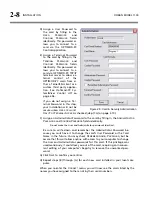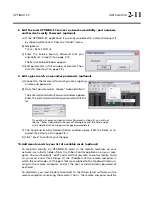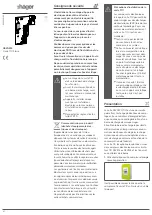
OPTIMOD-PC INSTALLATION
2-17
•
Connect the red (or white) wire to the pin on the XLR-type connector (#2 or #3)
that is considered HIGH by the standards of your organization. Connect the
black wire to the pin on the XLR-type connector (#3 or #2) that is considered
L
OW
by the standards of your organization.
•
In low RF fields (like a studio site not co-located with an RF transmitter), connect
the cable shield at OPTIMOD-PC input only—it should not be connected at the
source end. In high RF fields (like a transmitter site), also connect the shield to
pin 1 of the male XLR-type connector at OPTIMOD-PC input.
•
If the output of the driving unit is unbalanced and does not have separate
CHASSIS GROUND and (–) (or LOW) output terminals, connect both the shield
and the black wire to the common (–) or ground terminal of the driving unit.
Analog Audio Monitor Output
Electronically balanced and floating outputs simulate a true transformer output. The
source impedance is 50
Ω
. The output is capable of driving loads of 600
Ω
or higher.
The peak output level is adjustable up to +20dBu before clipping occurs. The out-
puts are EMI suppressed.
•
If an unbalanced output is required (to drive unbalanced inputs of other equip-
ment), it should be taken between pin 2 and pin 3 of the XLR-type connector.
Connect the LOW pin of the XLR-type connector (#3 or #2, depending on your
organization’s standards) to circuit ground, and take the HIGH output from the
remaining pin. No special precautions are required even though one side of the
output is grounded.
•
Use two-conductor foil-shielded cable (Belden 8451, or equivalent).
•
At OPTIMOD-PC’s output (and at the output of other equipment in the system),
do not connect the cable’s shield to the CHASSIS GROUND terminal (pin 1) on
the XLR-type connector. Instead, connect the shield to the input destination.
Connect the red (or white) wire to the pin on the XLR-type connector (#2 or #3)
that is considered HIGH by the standards of your organization. Connect the
black wire to the pin on the XLR-type connector (#3 or #2) that is considered
LOW by the standards of your organization.
AES3 Digital Input and Output
There are two AES3 inputs and one AES3 output. Both inputs accept program audio
and can be mixed; either input can also accept AES11 house sync. The program in-
puts and output are both equipped with sample rate converters. The output can op-
erate at 32, 44.1, 48, 88.1, and 96 kHz. The inputs can receive sample rates between
30 and 96 kHz; two asynchronous digital inputs can therefore be mixed.
Per the AES3 standard, each digital input or output line carries both the
left and right stereo channels. The connection is 110
Ω
balanced. The
AES3 standard specifies a maximum cable length of 100 meters. While
almost any balanced, shielded cable will work for relatively short runs (5
meters or less), longer runs require used of 110
Ω
balanced cable like
Belden 1800B, 1801B (plenum rated), multi-pair 180xF, 185xF, or 78xxA.
Содержание OPTIMOD-PC 1100
Страница 1: ...Operating Manual OPTIMOD PC 1100 Digital Audio Processor on a PCI Sound Card Software Version 2 0...
Страница 4: ......
Страница 5: ...Operating Manual OPTIMOD PC 1100 Digital Audio Processor on a PCI Sound Card Software Version 2 0...
Страница 18: ......
Страница 54: ......
















































